
Newton House at the heart of Dynevor Park
IN 1978, AFTER much hand wringing, the petrified stump of the aforementioned MERLIN’S OAK was removed, very carefully, to the Civic Hall, because it was obstructing the traffic. The good people of Carmarthen have been holding their breath ever since. The Welsh name for Carmarthen, Caerfyrddin, means Merlin’s Camp, and according to Geoffrey of Monmouth, the wizard was born here. He is said to be here still, imprisoned by a nymph called Vivien, in a cave on Merlin’s Hill, just outside the town.
Carmarthen occupies the site of Moridunum, THE MOST WESTERLY ROMAN FORT IN BRITAIN, and shares with Caerleon in Monmouthshire the accolade of being THE OLDEST TOWN IN WALES. Remains of the Roman amphitheatre, one of only seven of its kind in Britain, can be seen off Priory Street, near where Merlin’s Oak used to stand. Priory Street recalls the Augustinian Priory of St John, founded here in the 11th century, and where the BLACK BOOK OF CARMARTHEN was written in 1105. This is THE OLDEST BOOK IN THE WELSH LANGUAGE and is held in the National Library of Wales in Aberystwyth.
Carmarthen is THE MOST LONG-STANDING COUNTY TOWN IN WALES, having been given this status by Edward I in 1284, when he created the shire. Until the Industrial Revolution it was THE BIGGEST TOWN IN WALES.
Buried beneath a grand tomb in the 14th-century church of St Peter is SIR RHYS AP THOMAS (1449–1525), who led the Welsh support for Henry Tudor at the Battle of Bosworth Field in 1485.
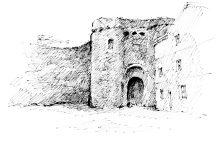
Also buried here is the essayist and dramatist SIR RICHARD STEELE (1671–1729) who, along with his Charterhouse classmate Joseph Addison, founded and published a number of influential 18th-century periodicals, including The Tatler (1709–11), the Spectator (1711–12) and the Guardian (1713), as well as THE FIRST THEATRICAL PAPER, the Theatre (1720). After the death of his second wife, Mary Scurlock, in 1718, heavy debts forced Steele to move to Wales, where he lived in Mary’s house Ty Gwyn, at Llangunnor, just outside Carmarthen, now a farmhouse. He later moved into Carmarthen to what became the Ivy Bush Hotel, later the scene of a famous Eisteddfod in 1819 (see Cardiganshire). He was buried in the Scurlock vault in St Peter’s, wearing a wig with black bow.
Someone else who moved to Carmarthen because of debts was the architect JOHN NASH, who lived here for 12 years. Sadly, little of the work he did in the town remains.
The landlord of the Ivy Bush Hotel in the 19th century was the father of Major-General Sir William Nott, victor of the first Afghan War in 1840, after whom Carmarthen’s Nott Square is named.
Friend of Chopin and composer of ‘God Bless the Prince of Wales’, BRINLEY RICHARDS, was born in Hall Street in 1817.
In 1966, GWYNFOR EVANS gave his acceptance speech at Carmarthen Guildhall on winning the Carmarthen by-election and becoming THE FIRST PLAID CYMRU MEMBER OF PARLIAMENT.

HIDDEN AWAY IN the hills north of Llandeilo is one of the main reasons that the Romans came to Wales – there is, in fact, GOLD in them thar hills. DOLAUCOTHI, near the village of Pumpsaint (Five Saints), is THE ONLY KNOWN ROMAN GOLD-MINE IN BRITAIN. The gold from here, intended for the Imperial Mint in Rome, was retrieved partly by open-cast mining and also by driving shafts known as ‘adits’ horizontally into the hillside – the openings to these works, concealed by trees and rock falls, pockmark the slopes. The Romans cut ingenious stone aqueducts into the terrain, one of them over 7 miles (11 km) long, to bring water to the mines for washing the ore, and some sections of these aqueducts can still be traced. They abandoned Dolaucothi in about AD 140, and the mines lay undisturbed for centuries until they were reopened on a small scale in 1844. In 1867, while using explosives to open up new adits, workers came across wooden artefacts over 2,000 years old, at depths of 160 feet (50 m) or more. Dolaucothi finally closed for good in 1938, and the whole site is now run by the National Trust, who organise guided tours into the mines.
FOR A BRIEF but glorious time in the 1920s, Wales was at the centre of world land speed records, and a Welshman was the fastest man on earth. The six-mile stretch of Pendine Sands on Carmarthen Bay were the Bonneville salt flats of their day, and the setting for a gripping contest between speed hero SIR MALCOLM CAMPBELL and a motor engineer from Wrexham, JOHN PARRY THOMAS. In 1924, Campbell broke the world land speed record on Pendine Sands, reaching 146.16 mph (235.17 kph) in his V12 Sunbeam, the first of his famous Bluebirds. In July 1925, Campbell became the first man to exceed 150 mph (241.35 kph), again on Pendine Sands. The following year Parry Thomas took to the sands in a huge, 27,000-litre, aero-engined monster he had acquired from his friend Count Zborowski, tragically killed at the Monza Grand Prix the year before. Zborowski had built his own cars, which became known as Chitty Chitty Bang Bangs after the noise emitted from their exhaust pipes – one such car inspired Ian Fleming’s book of the same name. Parry Thomas re-designed his Chitty Chitty Bang Bang, named it ‘Babs’ and, in 1926, set a new world record of 171.02 mph (275.17 kph) on Pendine Sands.


In February 1927, Malcolm Campbell just managed to snatch the record back at Pendine with an average speed of 174.8 mph (281.25 kph). Parry Thomas was not going to stand for that. On 3 March he took a slightly modified Babs for another run across the sand, just missing the record. On his second attempt, the car overturned at 180 mph (289.62 kph) and Parry Thomas was killed instantly, decapitated by the broken drive chain.
This was the last world land speed record attempt made at Pendine. For more than 40 years Babs lay buried in the sand where she had crashed, until, in 1969, she was uncovered and slowly restored to her original condition. Babs now sits proudly in the Museum of Speed in Pendine village.
In 1933, flying ace AMY JOHNSON and her husband JIM MOLLISON took off from Pendine Sands and achieved THE FIRST EVER NON-STOP FLIGHT FROM BRITAIN TO THE USA. Their aircraft ran out of fuel and crash landed at an aerodrome in Connecticut, just short of their ultimate destination of New York, slightly injuring both pilots.
During the Second World War Pendine Sands were taken over by the Ministry of Defence for use as a firing range. In 1943, Winston Churchill, General Eisenhower and Field-Marshal Montgomery stood on the beach at Wiseman’s Bridge to watch as 100,000 men stormed ashore during rehearsals for the D-Day Normandy landings.
In June 2002 Sir Malcolm Campbell’s grandson, Don Wales, evoked some nostalgia by bringing a Bluebird back to Pendine Sands and setting a speed record – the UK electric land speed record of 137 mph (220 kph), in Bluebird Electric 2.
Pendine Sands are still owned by the MoD, and on some days access is restricted, but the vast beach is now more of a holiday destination – there are some who wish that the MoD would train their guns on the swarming caravan parks that have sprung up as far as the eye can see.
IN THE SLOPING hillside churchyard of 13th-century St Martin’s, set back from the road, there is a simple white wooden cross that brings people from all over the world to this most lovely and remote of Welsh towns, set on the ‘mussel pooled and heron priested shore’ of the Taf estuary. Here, above LAUGHARNE, the ‘strangest town in Wales’, where he ‘got off the bus and forgot to get on again’, lies the best-known Welsh poet of them all, DYLAN THOMAS (1914–53). From the church it is a gentle walk into the town, along a road lined with sweet Georgian houses. It takes you past Thomas’s favourite Brown’s Hotel, where he would sup his midday bitter and listen to the gossip, past his parents’ home opposite, past the Rose and Crown, now ‘Dylan’s Diner’, on past the castle and over the cliffs, along Dylan’s Walk, to finally look down upon the BOAT HOUSE, squeezed between the cliff and the water’s edge. Thomas spent the last four years of his life in this ‘seashaken house on a breakneck of rocks’.

The local people seem indifferent to the excitement of those who come here to worship Dylan Thomas, perhaps because they, like the poet himself, came here to get away from it all, or perhaps because they slightly resent being looked at as characters out of Under Milk Wood – however much Thomas tried to deny it, the rest of the world, if not all the critics, see Laugharne and its inhabitants as the model for Llareggub. After all, if you reverse the letters you will discover what Dylan Thomas thought happened in Laugharne – which is the main reason why he wanted to live here.
Thomas came to live in Laugharne in 1938, but it was not until 1949 that he moved into the Boat House with his wife Caitlin and their two children – a third child, Colm, was born there. The Boat House was bought for them, for £3,000, by Mrs Taylor, the wife of the historian A.J.P. Taylor. Above the Boat House, springing out from the cliff and supported at one end by steel legs anchored in the garden below, is a blue-painted wooden shed, with a board over the door on which is written: ‘In this building Dylan Thomas wrote many of his famous works seeking inspiration from the panoramic view of the estuary’. A glass window inserted in the door allows the pilgrim to gaze in at the small, plain, sparsely furnished room where Thomas worked every afternoon, and where he composed Under Milk Wood. The shed had originally been built as a garage, to house a previous owner’s German DKW car which had no reverse gear, and therefore needed to be garaged on the flat, where it could be easily manhandled in and out.
Like so many of the best writers, Dylan Thomas drank too much, was exciting to know, impossible to live with, and always in debt. It was the drink that finished him, in a New York bar in 1953, at the age of 39, while he was on a speaking tour of America to try to raise some money. Many years later, as a tribute to his idol, the American singer Robert Allen Zimmerman changed his own name – to Bob Dylan.
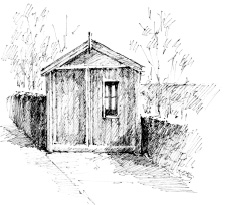
The Boat House is now open to the public.
Laugharne’s picturesque castle, subject of a dramatic painting by J.M.W. Turner, dates from the 13th century and was transformed into a comfortable dwelling by Sir John Perrot, an illegitimate son of Henry VIII. Between the wars, RICHARD HUGHES, author of A High Wind in Jamaica, lived in Castle House next door.
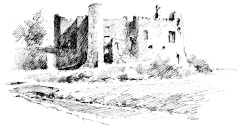
LLANELLI IS THE largest town in Carmarthenshire and is famous for its rugby team, the SCARLETS, who celebrated their centenary in 1972 by beating the New Zealand All Blacks at Stradey Park. Many of the great Welsh rugby players were nurtured by the Scarlets, including Barry John, Gareth Edwards and J.P.R. Williams. The rugby posts at Stradey Park are topped with saucepans, and the club’s anthem ‘Sospan Fach’ (Little Saucepan) is a tribute to Llanelli’s industrial heritage – the town was once THE LARGEST MANUFACTURER OF TINPLATE IN THE WORLD. The TROSTRE plant on the edge of the town is now THE ONLY TINPLATE WORKS LEFT IN BRITAIN.
At the start of the 20th century, Stepney Street in Llanelli became famous for the production of a hugely successful invention by Walter Davies, the STEPNEY SPARE MOTOR WHEEL, an inflated tyre on a solid spokeless rim that could be temporarily attached to a car wheel in the event of a puncture. Stepney Wheels were sent all over the world, and in India the term is still applied to any spare tyre.
LLANELLY HOUSE in Bridge Street is widely praised as ‘THE FINEST GEORGIAN TOWN HOUSE IN WALES’. It was restored to pristine condition as a result of being voted the Welsh finalist in the BBC Restoration programme of 2005.

BESIDE THE ROAD at EFAILWEN there is a commemorative stone that marks the site of the first of the ‘REBECCA RIOTS’, which took place on the night of 13 May 1839, when the ‘Daughters of Rebecca’ attacked a tollgate operated here by the Whitland Turnpike Trust. It was a time of severe economic depression after the Napoleonic Wars, and the local farmers disguised themselves as women to protest against having to pay tolls to use poorly maintained roads, something they saw as a symbol of oppression. The riots continued sporadically until 1843, with miners and metalworkers joining in, and although they became increasingly violent and many of the ringleaders were transported to Australia, the 1844 Turnpike Trust Act conceded many of their demands. The Daughters of Rebecca took their name from The Book of Genesis, Chapter 24, Verse 60: ‘And they blessed Rebekah and said unto her, “and let thy seed possess the gates of those which hate them”.’
Stage actress RACHEL ROBERTS was born in Llanelli in 1927. She was married to Rex Harrison for nine years.
Actress SIAN PHILLIPS was born in Betws, near Ammanford, in 1934. Perhaps best known for her role as the devious Livia in the BBC TV series I Claudius, Sian was married for 20 years to hell-raising actor Peter O’Toole.
Actor HYWEL BENNETT, best known for playing the title role in the long running television sitcom Shelley, was born in Garnant, near Ammanford, in 1944.
Rugby star BARRY JOHN was born in Cefneithin, Llanelli, in 1945.
Rugby star GARETH EDWARDS was born in Gwaun-cae-gurwen, near Ammanford, in 1947. He won A RECORD 53 CONSECUTIVE WELSH CAPS between 1967 and 1978.
Rugby star JONATHAN DAVIES was born in Trimsaran in 1962.
Alone in the Tabernacle cemetery at GLANAMAN, beneath the Black Mountains, lies JAMES COLTON (1858–1936), a miner who was married to one of the most controversial figures of the early 20th century, feminist and anarchist Emma Goldman (1869–1940), described by J. Edgar Hoover as ‘the most dangerous woman in America’. Colton sympathised with Goldman’s views and admired her courage in standing up for them, and he offered to marry her so that she could gain a British passport, after she was thrown out of the USA. In Warren Beatty’s epic film Reds, Emma Goldman was played by Maureen Stapleton, who won an Oscar for the role.
An obelisk in LLANFAIR-AR-Y-BRYN CHURCHYARD outside Llandovery marks the resting-place of WILLIAM WILLIAMS, PANTYCELYN (1717–91), one of Wales’s great hymn writers, composer of, amongst other hymns, ‘Guide Me, O Thou Great Jehovah’.
Buried in a modest family vault in the lonely churchyard at CAEO, near Llandovery, is a victim of one of the most infamous Victorian melodramas of the 19th century. JUDGE JOHN JOHNES was murdered in the study of his ancestral home, Dolaucothi, by his butler, HARRY TREMBLE, whom he had just dismissed. The butler did it, and then killed the Judge’s dogs before turning the gun on himself. Tremble’s body was left lying by the side of the road for some time before eventually being buried in the churchyard in an unmarked grave. Also buried with the Johnes family is SIR JAMES HILL-JOHNES (1833–1919) who, as James Hill, won a Victoria Cross at the siege of Delhi in 1857, and married Judge Johnes’s daughter in 1882.
Carmarthenshire is THE LARGEST COUNTY IN WALES.
The NATIONAL BOTANICAL GARDEN OF WALES opened in the grounds of Middleton Hall in Llanarthne, east of Carmarthen, in 2000 – THE FIRST NEW NATIONAL BOTANICAL GARDEN OF THE NEW MILLENNIUM ANYWHERE IN THE WORLD.
The GREAT GLASSHOUSE in the Botanic Garden was designed by Sir Norman Foster and IS THE LARGEST SINGLE-SPAN GLASSHOUSE IN THE WORLD, 312 ft (95 m) long and 180 ft (55 m) wide. The glasshouse is home to over 1,000 species of plant and is able to recreate a number of climates, including those of Chile and South Australia. In a 2006 nationwide poll to decide the Seven Wonders of Wales, it was voted No. 1 by readers of the Western Mail, just ahead of Mt Snowdon.

PAXTON’S TOWER, a Gothic folly and banqueting hall 1 mile (1.6 km) to the north, has spectacular views over the gardens as well as the Twyi valley. It was built around 1810 for a former owner of Middleton Hall, William Paxton, a banker who had made his money in India. The tower is dedicated to Lord Nelson.
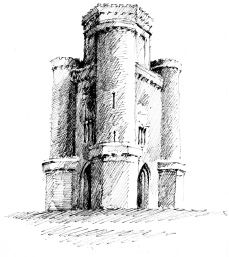
Paxton’s Tower
The garden at ABERGLASNEY, near Llandeilo, is one of the oldest in Britain. It was first mentioned in 1477 by the bard Lewis Glyn Cothi, who described it as ‘a white painted court, built of dressed stone, surrounded by nine gardens of orchards, vineyards and large oak trees’. In the 17th century the estate was bought by Bishop Anthony Rudd of St David’s, who laid out the gardens in the style we see them today. They have been restored by the Aberglasney Restoration Trust as a unique example of a Jacobean garden and include a parapet walk that is THE ONLY SURVIVING EXAMPLE OF ITS KIND IN BRITAIN.
The hill fort of CARN COCH, 700 ft (213 m) up in the foothills of the Black Mountains between Llandovery and Llandeilo, is THE LARGEST HILL FORT IN WALES and covers and area of some 15 acres (6 ha).
Below Carn Coch is BETHLEHEM, a small community that takes its name from a nonconformist chapel on the hillside. At Christmas time the village post office is inundated with sacks of Christmas cards from across Britain, all sent here to be appropriately franked.
TALLEY ABBEY, established in 1180 and now a peaceful ruin set in wooded country north of Llandeilo, is THE ONLY HOUSE OF THE ORDER OF THE WHITE CANONS TO BE FOUNDED IN WALES.
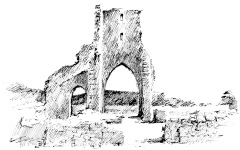
Just north of Llandovery is the graceful DOLAUHIRION BRIDGE across the River Twyi, built by William Edwards. When it was constructed in 1773 it was one of the longest single-span bridges in the world – outdone only by another bridge designed by Edwards, the famous bridge across the River Taff at Pontypridd.
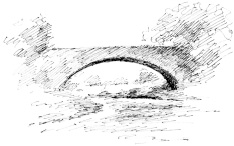
CAPEL YSTRAD FFIN, a tiny, single-chambered church on the Cardigan border near Llyn Brianne, was founded in 1117, and used to belong to the monks of Strata Florida. It was rebuilt by the Cawdor family in 1821 and is thought to have been used as THE FIRST MEETING-PLACE FOR METHODISTS IN WALES.
Built in 1972, the LLYN BRIANNE DAM, north of Llandovery, is 299 ft (91 m) high, THE HIGHEST DAM IN BRITAIN.
The main road into the picturesque hilltop market town of LLANDEILO crosses the River Twyi over THE LONGEST STONE ARCH IN WALES. THE TWYI BRIDGE was built in 1848 and is 365 ft (111 m) long with a central span of 145 ft (44 m).
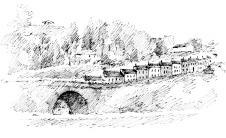
CARREG CENNEN CASTLE, 4 miles (6.4 km) south-east of Llandeilo, has the most commanding and impressive situation of any castle in Wales. It stands on top of a limestone crag with a sheer drop of 300 ft (91 m) to the River Cennan below, and dominates the countryside beneath the Black Mountain. The crag has been fortified since before Roman times, but the present ruins date from the 13th century and create an unmistakable landmark that has lured generations of visitors and artists, notably Turner, to this remote spot. A steep, walled passageway, lit by a succession of arched windows, tunnels its way down the cliff face and leads to a cavern where prehistoric remains have been found. The views are sensational.
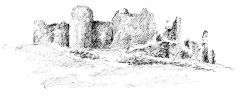
On 17 June 1928, history was made at BURRY PORT, near Llanelli, when a seaplane called Friendship landed in the harbour after a flight of 20 hours and 49 minutes from Newfoundland. On board as a passenger was AMELIA EARHART, and she had just become THE FIRST WOMAN TO FLY ACROSS THE ATLANTIC. The buoy that Friendship was tethered to has been restored and sits proudly on the harbour front, along with a commemorative plaque and signposts showing the distances to Newfoundland and New York. Burry Port sits at the eastern end of CEFN SIDAN SANDS which, at 7 miles (11 km) long, is WALES’S LONGEST BEACH.